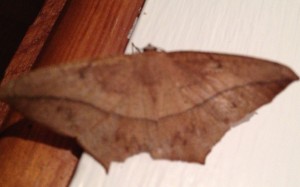When I came in from letting my dog out the other evening, a moth flew in behind us. Annoyed, I tried to gently catch it in my hand when it landed on the kitchen windowsill. As it stealthy escaped my grasp, its deep yellow, almost orange tiny eyes met mine.
A few minutes later, while I was eating dinner, I looked up and saw the moth on the wall with its wings spread. A stylish thin dark line ran across its tan and amber wings from tip to tip. The rich mosaic of color reminded me of marbled paper in antique books.
I snapped a picture of it on my phone and tried unsuccessfully to look it up in my guidebooks. Although many guidebooks include moths in the title, in the ones I have butterfly entries vastly outnumber moths.
Impatient, I turned to the Internet, that ever present source of knowledge and truth. The first website I found Butterflies and Moths of North America allows uploading an image and the site will search for a match within its vast database of. I was ecstatic. I admire crime shows like CSI, where the lab tech finds an image, taps a few keys on the keyboard, and viola!, the match is found. Unfortunately, it didn’t work that way for me: no match.
Next, I tried BugGuide, a site supported by a community of naturalists and sponsored by Iowa State University Entomology. On this site, subscribers help each other identify images. I uploaded my picture with a brief description of when and where I found it, and the next morning, viola!, I found a response from Nancy, who identified the image. “My” moth is a Prochoerodes lineola – Large Maple Spanworm.
At first, I thought spanworm was rather unattractive name, but when I looked it up, I learned it is basically another name for inchworm, which sounds more endearing than spanworm.
Although the vast majority of moths are perfectly benign, a few rouges like the Gypsy Moth and the few that tend to eat clothes and crops give moths a bad name.
In an article in The MN Conservation Volunteer, Susan Weller, curator of lepidopterans at the Bell Museum of Natural History, notes that a male moth can detect and will respond to pheromone emitted by a female five miles away. How is that for being responsive? She also explains that moths are marvelous nighttime pollinators, and even though “butterflies are the most obvious and best-known lepidopterans, they make up just 10 percent of the species in the order and are really just specialized moths.”
I agree with Dr. Weller. In addition to this moth, I saw an elegant black and silver moth on my garage a couple of weeks ago, perhaps a sphinx moth of one type or another. After pondering many photos of moths, I have become quite enamored with them.
Even though I dream of going to Madagascar someday to see amazing flora and fauna there, meeting a Prochoerodes lineola in my kitchen has reminded me of all of the wonders that can be found at home. For now, I am going to click my ruby slippers and open my eyes to more of what is right here around me. I am also going to by a good guidebook on moths.
© Virginia Wright-Peterson
